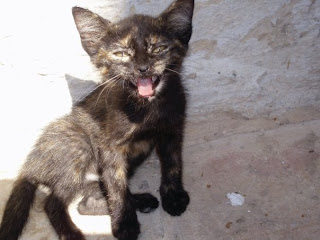Tuesday, November 30, 2010
Baraka
The film we watched in class portrayed many different photographic elements. It taught me about how different people around the world are based on their culture and where they are from. In one disturbing part of the film, people were killing chicks as if they were like flies. These innocent creatures were suffering as their wings were getting ripped off. The photographic element in which a small object looks as if it is large was used in this portion of the film by showing a close-up view of the chicks; however, the chicks looked a lot smaller when they were all going through the machines. As soon as I saw the first chick’s wings get torn off, I closed my eyes because I could not handle watching such cruelty. I could not believe that people in other countries treat animals in such a terrible way. I noticed that some people from other cultures do not see animal cruelty the same way I do, which led me to wonder if I would be able to rip off a chick’s wings if I were from some other country. That portion of the film caught my attention the most, but it was not the only part that concerned me; I was intrigued by the world poverty that was portrayed. This film frequently presented poverty by showing images of poor people along with their diverse culture.
After watching most of this film, I began to wonder what other issues people around the world are constantly dealing with. Although the movie only consisted of short random clips with no dialogue, it still really opened my eyes and made me think about subjects that would not have crossed my mind otherwise. If this entire film had been shot from with little variations of photographic elements, it certainly would not have had as strong of an effect on me.
Wednesday, November 17, 2010
Tuesday, November 9, 2010
Thursday, November 4, 2010
Video Notes
- the brownie camera was the first camera
- it was $1, so many people had them
- people barely ever took pictures before the brownie
- photography became a democratic art
- photos of foreigners showed America how the rest of the world was (Africa)
- Edward Curtis photographed Indians
- Gilberth used science for photography
- photos were used to try to end child labor
- people were moved and outraged by these pictures
- this led to the outlaw of child labor
- the modernist movement was called straight photography, which took things the way they were with no manipulations
- these photos were abstract and used a lot of shadows
- in World War 1, there were never pictures of dead American soldiers
Tuesday, November 2, 2010
Monday, October 25, 2010
Notes:114-125
Shoot a Formal Portrait
- be prepared for the shoot in advance
- have someone there to assist you
- place background close to wall, put a stool in front of the background for the subject to sit on
- place the light about 45 degrees to the right of the subject
- set the camera anywhere from 6-10 feet in front or your subect
- camera settings:
- shoot with a wide-open aperture to make the background out of focus
- this increases the shutter speed
- lighting:
- indoors: place one light at about a 45 degree angle on one side of subject and use a reflector on the opposite side
- outdoors: shoot in open shade
- candid portraits capture a person going about everyday life and activities
- background gives context and meaning
- camera settings:
- choose a fast shutter speed to freeze action; 1/250 and higher
- environment portraits use a subect's surroundings to help tell that person's story
- combination of a formal portrait and photojournalism
- camera settings:
- wide angle lenses
- in a self portrait you become your own subject
- can reveal as much or as little as you want about yourself
Thursday, October 21, 2010
Notes
Action shots
- slower shutter speeds are used to take more blurry pictures
- faster shutter speeds are used to take more sharp and detailed pictures
Tuesday, October 19, 2010
Friday, October 15, 2010
Thursday, October 7, 2010
Portrait notes
early portrait photography:
- painted portraits were expensive
- revealed subjects personally
- textures and shapes are less visible
Tuesday, October 5, 2010
Thursday, September 30, 2010
Wednesday, September 29, 2010
Career Photographer: Neil Leifer (Sports)
Neil Leifer became a professional photographer when he was a teenager. Beginning in 1960, his photography was regularly appearing in every major national magazine. By 1990, his photographs had appeared on more than 200 Sports Illustrated, Time, and People covers. He has published 14 books; 9 of them are collections of sports pictures. He has traveled all over the world on sports assignments.
http://216.117.181.169/
http://216.117.181.169/
Monday, September 27, 2010
Tuesday, September 21, 2010
Subscribe to:
Comments (Atom)





















































